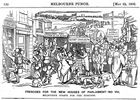Putting down roots
After the initial chaos and frenzy of the early days on the diggings, life in the goldfields settlements gradually developed into a more routine affair. Having struggled in a harsh environment to obtain the bare necessities of food and shelter, the population now looked for a more refined existence. Cultural institutions began to spring up amongst the mud, denuded landscape, and early commercial establishments. Some institutions, like schools and places of worship, were quick to emerge within the embryonic townships, while others, like hospitals, libraries and gardens, took many years and were only acquired with the wealth generated by gold.



